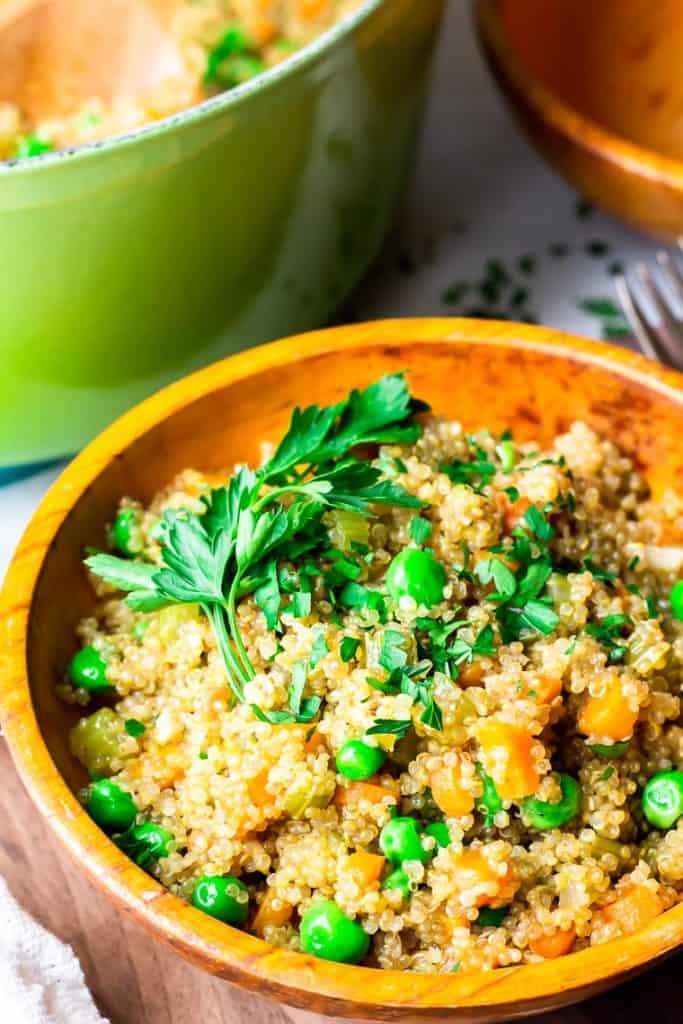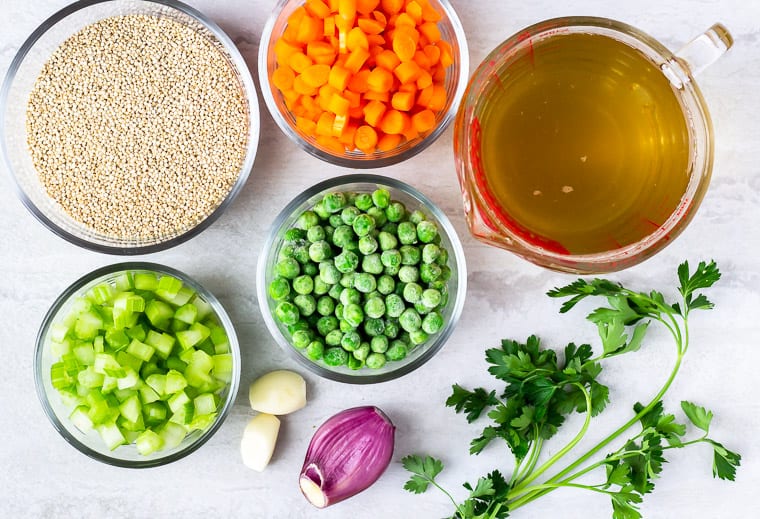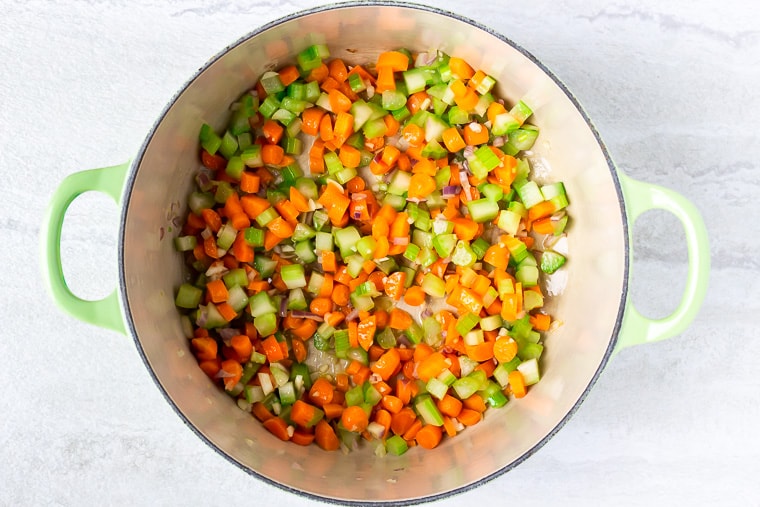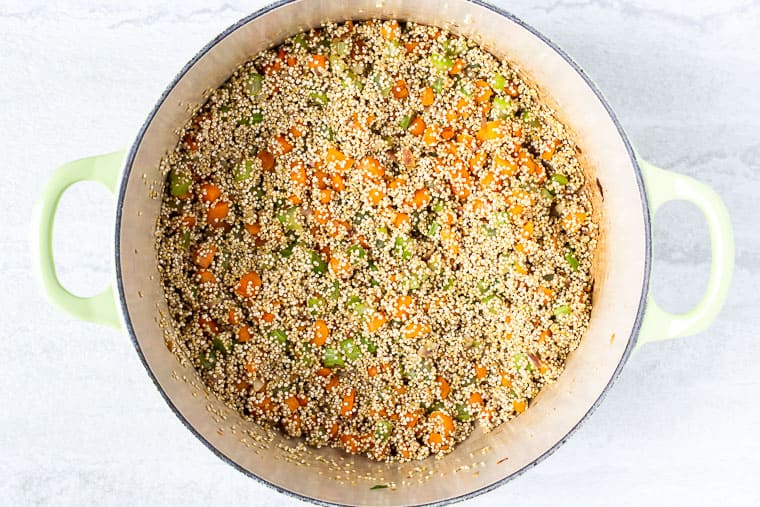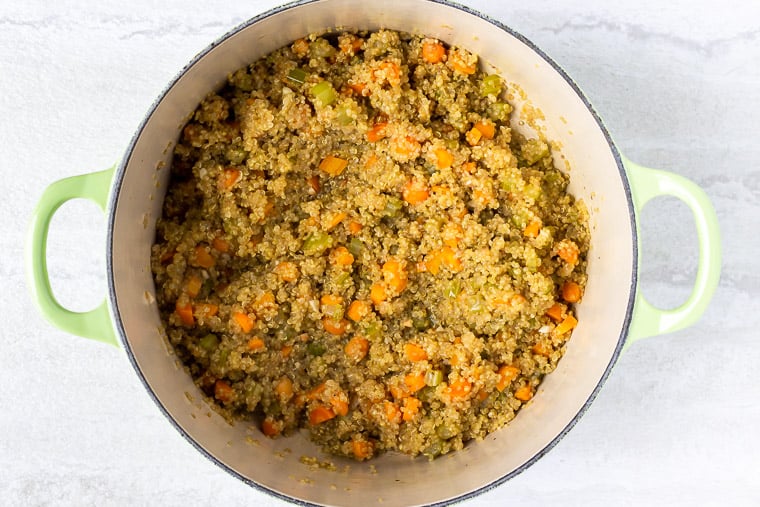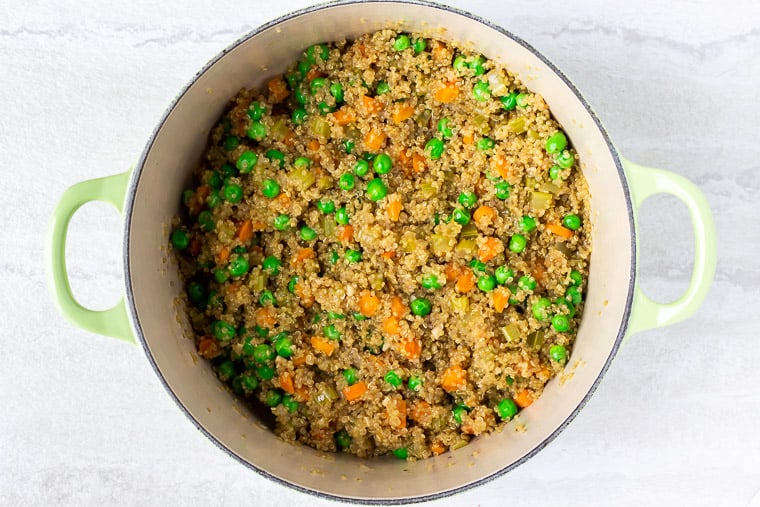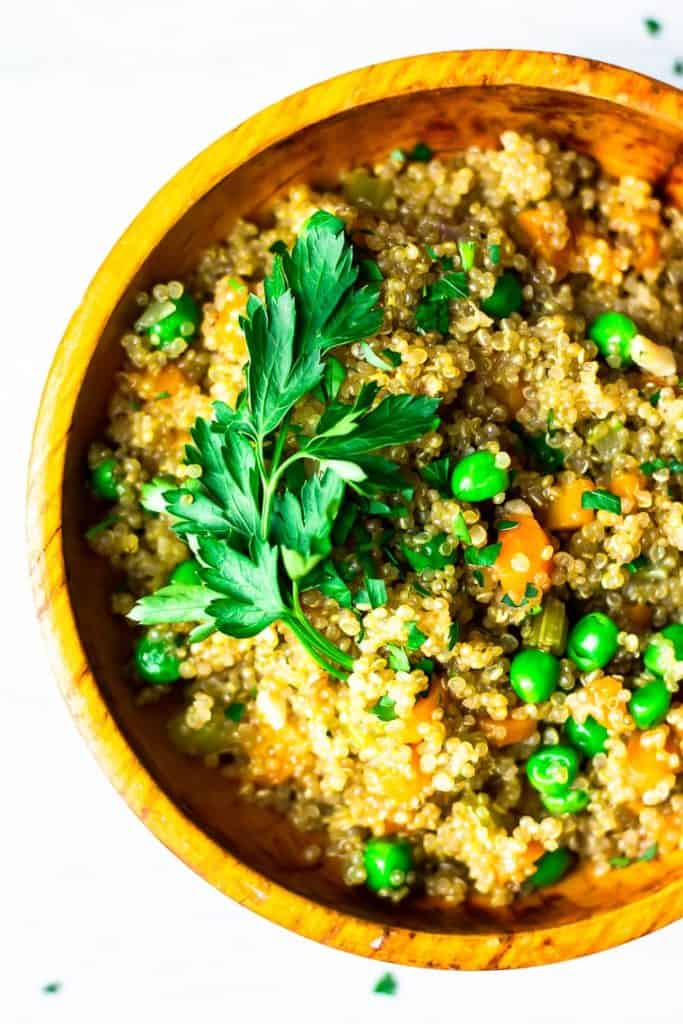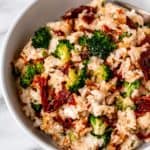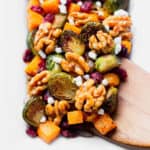This easy-to-make, healthy Quinoa Pilaf recipe is loaded with vegetables and flavor. It’s filling enough to be a main meal, but makes a perfect side dish, as well.
This post contains affiliate links. See our Disclosure Statement for more information.
Growing up, my mom always made a protein, a starch, and a vegetable for dinner. But quinoa never once made an appearance at our table back then. It’s much better known and used quite often these days.
I’ve used it as a compliment in recipes like Shrimp Quinoa Salad with Corn and Honey Lime Dressing, Sweet Potato, Black Bean & Quinoa Fritters, and Southwestern Chicken and Quinoa, but in this Quinoa Pilaf recipe, quinoa is the star!
What Is Quinoa?
My son recently asked me what quinoa was. I was pretty certain that it was a grain, but other than that, I didn’t really know much else about it.
It turns out that quinoa is actually not a grain, but rather seeds from a plant that is related to spinach and amaranth (also growing in popularity lately!).
It’s cooked and used very similar to grains and is high in protein and fiber. It has a mild, nutty flavor and a unique texture that’s fun to eat!
What Is Pilaf?
Pilaf is a rice dish in which rice is cooked in a stock. Often, other seasonings and vegetables are added to it. Rice pilaf is usually finished in the oven to cook the rice in such a way that it doesn’t stick together.
Why This Recipe Works
Like rice, quinoa is a very versatile food. You can use it as a base, or mix other foods and seasonings into it to serve as a side. You can even use it in soups and salads.
This recipe uses quinoa as a healthier alternative to rice in a pilaf-like recipe. There are plenty of vegetables mixed in and it’s cooked in vegetable stock for an even more flavor quinoa.
You can serve this naturally gluten free recipe as a side dish or enjoy it for a meal.
How to Make Quinoa Pilaf with Vegetables
What You Need To Make This Recipe
To make this recipe, you will need:
- 2 tablespoons extra virgin olive oil
- 2 cloves garlic (minced)
- 1 shallot (diced small)
- 2 carrots (diced small)
- 2 ribs celery (diced small)
- 1/2 teaspoon salt
- 1/2 teaspoon pepper
- 1 cup quinoa
- 2 cups vegetable stock (unsalted)
- 1/2 cup peas (frozen or fresh)
- fresh parsley (minced, optional garnish)
The entire recipe and instructions can also be found in the recipe card at the bottom of this post. You can also print the recipe from the card, if needed.
Prep!
Before you begin cooking, mince the garlic and dice the shallot, carrots, and celery into small pieces. Roughly chop the parsley if you are using it.
Rise the quinoa under cold water in a fine mesh strainer. This removes any bitter flavor that may be present in it’s natural coating.
Create!
Add the olive oil to a large skillet over medium-high heat.
Once hot, add the garlic, shallot, carrots, and celery. Season with salt and pepper. Cook until just tender, about 3-5 minutes.
Add the quinoa and cook until toasted and golden brown, stirring frequently, about 2 minutes.
Add the vegetable stock and bring to a boil. Lower the heat, cover, and simmer until the liquid is absorbed, the germ of the quinoa is visible, and it can be fluffed with a fork, about 15 minutes.
Tip: use unsalted vegetable stock so that you can control the amount of salt in the recipe. If you can’t find unsalted, go very light or omit the salt when cooking the vegetables.
Stir in the peas and heat through. Taste and season with additional salt and pepper, if needed.
Present!
Add the quinoa pilaf to a serving bowl and garnish with the fresh parsley, if desired.
Tips and Techniques
- Rinse the quinoa to remove any residual natural coating that may be present. This coating can give quinoa a bitter taste if not removed. Most quinoa has been pre–rinsed, but it won’t hurt to rinse it again.
- Use unsalted vegetable stock to better control the salt content of this recipe. If you can’t find unsalted stock, lessen or omit the salt when cooking the vegetables.
- Store leftovers in an airtight container in the refrigerator. Use within 3-5 days.
More Healthy Side Dish Recipes To Try
- Roasted Turnips
- Simple Roasted Rutabaga
- Sweet Potatoes and Apples with Cinnamon & Maple
- Butternut Squash Gratin
- Roasted Cabbage Wedges
- Green Bean Potato Salad
- Lemon Roasted Broccoli & Sweet Potatoes
- Honey Garlic Green Beans
Love this Quinoa Pilaf recipe? Follow me on Pinterest, Instagram, and Facebook for more!
If you try this recipe, please take a moment to leave a comment and a star rating. I would really appreciate it!
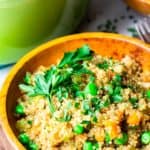
Quinoa Pilaf
Ingredients
- 2 tablespoons extra virgin olive oil
- 2 cloves garlic * minced
- 1 shallot * diced small
- 2 carrots * diced small
- 2 ribs celery * diced small
- 1/2 teaspoon salt
- 1/4 teaspoon pepper
- 1 cup quinoa * rinsed
- 2 cups vegetable stock * unsalted
- 1/2 cup peas
- fresh parsley * minced, optional garnish
Instructions
- Add the olive oil to a large skillet over medium-high heat.
- Once hot, add the garlic, shallot, carrots, and celery. Season with salt and pepper. Cook until just tender, about 3-5 minutes.
- Add the quinoa and cook until toasted and golden brown, stirring often, about 2 minutes.
- Add the vegetable stock and bring to a boil.
- Lower the heat, cover, and simmer until the liquid is absorbed, the germ of the quinoa is visible and it can be fluffed with a fork, about 15 minutes.
- Stir in the peas and heat through.
- Taste and season with salt and pepper, as needed. Garnish with fresh parsley, if desired.
Notes
Tips and Techniques
- Rinse the quinoa to remove any residual natural coating that may be present. This coating can give quinoa a bitter taste if not removed. Most quinoa has been pre–rinsed, but it won’t hurt to rinse it again.
- Use unsalted vegetable stock to better control the salt content of this recipe. If you can’t find unsalted stock, lessen or omit the salt when cooking the vegetables.
- Store leftovers in an airtight container in the refrigerator. Use within 3-5 days.
Nutrition
This recipe was originally published on March 14, 2018. It was updated with new images, an improved recipes, tips, techniques, and FAQ’s in April 2020.



